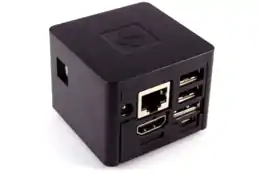CuBox
CuBox and CuBox-i are series of small and fanless nettop-class computers manufactured by the Israeli company SolidRun Ltd. They are all cube-shaped and sized at approximately 2 × 2 × 2 inches (5 cm) and weigh 91 grams (0.2 lb, or 3.2 oz).[2] CuBox was first announced in December 2011 and began shipping in January 2012, initially being marketed as a cheap open-source developer platform for embedded systems.[1][3][4][5][6][7][8]
 i.MX6-based CuBox (2014) | |
| Common manufacturers | Marvell or Freescale Semiconductor |
|---|---|
| Design firm | SolidRun |
| Introduced | CuBox 11 December 2011[1] |
| Cost | 99 euro (~US$135) |
| Type | Single-board computer |
| Processor | Marvell Armada 510 ARMv7 or i.MX6 |
| Frequency | From 800 MHz and upwards |
| Memory | From 1 GB and upwards |
| Coprocessor | VFPv3 (VFP/FPU) WMMX / WMMX2 SIMD vMeta Video Decoder Vivante GC600 GPU Two XOR/DMA Engines and PDMA TrustZone CESA PMU (Power Management Unit) |
| Ports | HDMI 1.3 with CEC S/PDIF (optical output) 1000baseT Ethernet 2 × USB 2.0 host ports 1 × eSATA (3 Gbit/sec) IrDA (InfraRed) receiver MicroUSB (console only) MicroSD slot (comes with 2 GB MicroSD SDXC, upgradable to 64 GB) |
| Power consumption | 3 W @ 5 V, 2 A DC |
| Weight | ~91 g |
| Dimensions | 55 × 55 × 42 mm |
The first-generation CuBox was according to SolidRun the first commercially available desktop computer based on the Marvell Armada 500-series SoC (System-on-Chip) and at the time was said to be the world's smallest desktop computer.[9]
In November 2013, SolidRun released the Cubox-i1, i2, i2eX, and i4Pro, containing i.MX6 processors.[10][11]
Overview
CuBox is a low-power computer based on ARM-architecture CPU, using the Marvell Armada 510 (88AP510) SoC with an ARM v6/v7-compliant superscalar processor core, Vivante GC600 OpenGL 3.0 and OpenGL ES 2.0 capable 2D/3D graphics processing unit, Marvell vMeta HD Video Decoder hardware engine, and TrustZone security extensions, Cryptographic Engines and Security Accelerator (CESA) co-processor.[5][12]
Despite being about 2-inch-square in size, the platform can stream and decode 1080p content, use desktop-class interfaces such as KDE or GNOME under Linux, while requiring less than 3 watts and less than 1 watt in standby.[13]
SolidRun currently officially only supports Linux kernel 2.6.x or later and Android 2.2.x and later. It comes with Ubuntu Desktop 10.04 and Android 2.2 dual-boot pre-installed.[1]
Newer models
In November 2013, SolidRun released a family of CuBox-i computers named CuBox-i1, i2, i2eX, and i4Pro, containing a range of different i.MX6 processors by Freescale Semiconductor.[10][11]
They have also released a series of caseless i.MX6 models called the Hummingboard.[14]
CuBoxTV
Announced in December 2014, CuBoxTV is a mid-range and simplified version of the CuBox-i computer. It is designed to exclusively operate KODI (formerly known as XBMC) on an OpenELEC operating system.[15]
CuBoxTV weighs approximately 9.9oz (281 grams), and is around 2X2 Inches wide and 1.8 inches high, shaped like a cube with rounded sides. It features an i.MX6 Quad core processor at a 1GHz speed, 1GB of RAM memory, 8GB base storage memory and a GC2000 OpenGL quad shader GPU. It houses a couple of USB 2.0 ports, a HDMI port, microSD port and an Ethernet port.[16]
References
- "Archived copy". Archived from the original on 2 February 2013. Retrieved 10 January 2012.CS1 maint: archived copy as title (link) CuBox Developer Platform Announcement
- http://www.cnx-software.com/2013/09/05/solidrun-announces-cubox-i-platform-with-freescale-i-mx6-for-as-low-as-45/ SolidRun Announces Cubox-i Platform with Freescale i.MX6 for as low as $45.
- CuBox is a sexy, ice cube-sized ARM computer.
- CuBox – Ice Cube Sized ARM Computer.
- Android-ready ARM mini-HTPC costs $130, uses just three Watts.
- Solid-Run CuBox: Open Source Platform for Android TV, Media Center and NAS Development.
- Move over Raspberry Pi: CuBox enters the fray with 1GB DDR3 RAM, dualcore CPU, HDMI, GBit LAN… all inside a cubed box Archived 10 January 2012 at the Wayback Machine.
- Meet CuBox – A Tiny ARM Powered Media Centre Capable of Running Ubuntu.
- Solid-Run CuBox: World's Smallest HTPC (video).
- "CuBox-i Series Release". Archived from the original on 14 July 2014. Retrieved 11 July 2014.
- "CuBox-i Hardware". Archived from the original on 14 July 2014. Retrieved 11 July 2014.
- Marvell expands range of ARM SoCs.
- XBMC on SolidRun Platform named CuBox on YouTube.
- "Hummingboard Release". Archived from the original on 14 July 2014. Retrieved 11 July 2014.
- Lehrbaum, Rick (20 December 2014). "Hands-on review: CuBoxTV running OpenELEC+Kodi and Android". LinuxGizmos.com. Retrieved 4 June 2015.
- "CuBoxTV Tech Specs". CuBoxTV.com. Archived from the original on 2 June 2015. Retrieved 4 June 2015.

